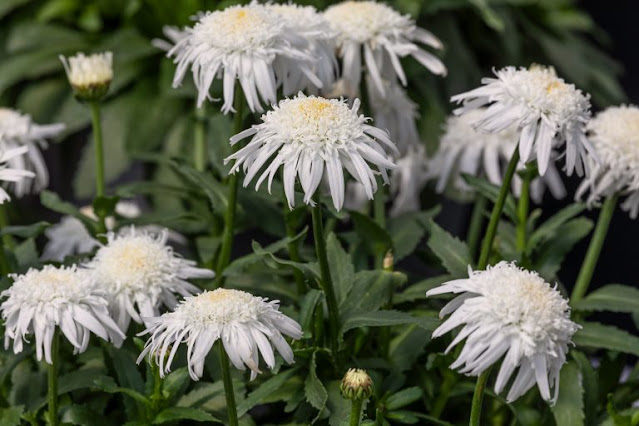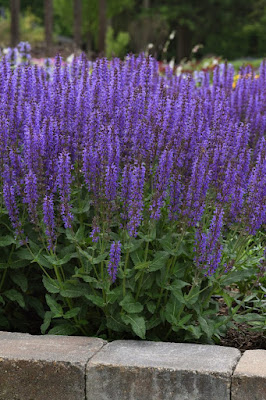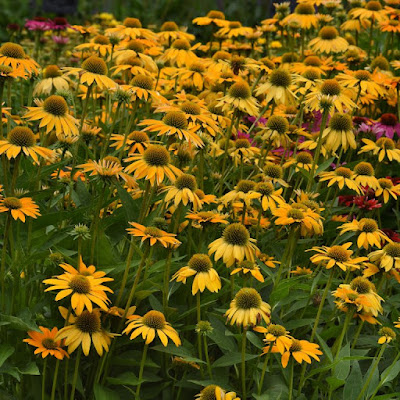
All-America Selection winners include new salvia, coneflower and groundcover Shasta daisy

|
| Carpet Angel is a new groundcover Shasta daisy, among the just-announced 2023 All-America Selections perennial winners. (Photos courtesy All-America Selections) |
Gardeners are always looking ahead. We have to! It takes time to go from seed to bloom or harvest.
So, in the middle of Summer 2022, we’re looking forward to Summer 2023 and the new varieties we’ll see (and grow) next year.
Whetting our appetite for new flowers is the announcement this week of the first 2023 All-America Selections winners. The AAS committee dribbles out its winners list, and the first to be revealed are three perennials that are improvements on old favorites.
National perennial winner is a pretty blue sage that can handle both extreme cold and blast-furnace heat. Blue By You salvia ( https://tinyurl.com/m5bm86cd ), developed by Chicago-based Darwin Perennials, offers six months of bloom with little effort.

|
| Blue By You salvia is a national AAS winner. |
A hybrid between Salvia nemorosa and Salvia pratensis , Blue by You is a bee magnet. It needs average irrigation and grows about 20 to 22 inches tall. Another plus: Deer don’t like it.
Two regional winners also were revealed: A hybrid coneflower and a groundcover Shasta daisy.
Artisan Yellow Ombre echinacea ( https://tinyurl.com/5xyxwy6w ), developed by PanAmerican Seed (which does a lot of plant breeding and testing in Yolo County), is an improved coneflower with strong, straight stems – great for cutting. Named the Southeast and Northwest regional winner, it grows 24 to 30 inches tall and blooms continuously for months.
(Both Darwin Perennials and PanAmerican Seed are part of Ball Horticultural.)
“Artisan Yellow Ombre is a great plant for anyone wanting vibrant color all season long in their perennial garden, or to use as a cut flower,” says the AAS committee.

|
|
Artisan Yellow Ombre coneflower was named a regional winner.
|
Other colors in the Artisan series of coneflowers (so far) include Red Ombre and Soft Orange.
The most unusual All-America Selection winner may be the groundcover Shasta daisy Carpet Angel ( https://tinyurl.com/5n873mun ); it was named the West regional winner. The only AAS winner of its kind, it’s also the first AAS winner for breeder Green Fuse Botanicals of Santa Paula, Calif.
“Green Fuse Botanicals’ First Light Perennials is a program of first-year flowering perennials that are day-length neutral, meaning earlier blooms that continue all season long,” explains the AAS committee. “Large 3-inch flowers boast a second inner frilly bloom adding to the unique look of Carpet Angel.
"Growing only to a height of 6 inches, this unique Leucanthemum can act as a groundcover spreading up to 20 inches wide. Fantastic branching on this new AAS winner means more flower stems sporting beautiful pure white blooms that look like angels dancing over a carpet of dark green foliage. A little deadheading of spent flowers will reward you with even more blooms.”
Look for these plants in nurseries and plant catalogs next spring.
Learn more about All-America Selections and how these plants were tested: https://all-americaselections.org/ .
Comments
0 comments have been posted.Sacramento Digs Gardening to your inbox.
Food in My Back Yard Series
May 6: Maintain soil moisture with mulch for garden success
April 29: What's (already) wrong with my tomato plants?
April 22: Should you stock up on fertilizer? (Yes!)
April 15: Grow culinary herbs in containers
April 8: When to plant summer vegetables
April 1: Don't be fooled by these garden myths
March 25: Fertilizer tips: How to 'feed' your vegetables for healthy growth
March 18: Time to give vegetable seedlings some more space
March 11: Ways to win the fight against weeds
March 4: Potatoes from the garden
Feb. 25: Plant a fruit tree now -- for later
Feb. 18: How to squeeze more food into less space
Feb. 11: When to plant? Consider staggering your transplants
Feb. 4: Starting in seed starting
Sites We Like
Garden Checklist for week of May 11
Make the most of the lower temperatures early in the week. We’ll be back in the 80s by Thursday.
* Plant, plant, plant! It’s prime planting season in the Sacramento area. Time to set out those tomato transplants along with peppers and eggplants. Pinch off any flowers on new transplants to make them concentrate on establishing roots instead of setting premature fruit.
* Direct-seed melons, cucumbers, summer squash, corn, radishes, pumpkins and annual herbs such as basil.
* Harvest cabbage, lettuce, peas and green onions.
* In the flower garden, direct-seed sunflowers, cosmos, salvia, zinnias, marigolds, celosia and asters. (You also can transplant seedlings for many of the same flowers.)
* Plant dahlia tubers.
* Transplant petunias, marigolds and perennial flowers such as astilbe, columbine, coneflowers, coreopsis, dahlias, rudbeckia and verbena.
* Keep an eye out for slugs, snails, earwigs and aphids that want to dine on tender new growth.
* Feed summer bloomers with a balanced fertilizer.
* For continued bloom, cut off spent flowers on roses as well as other flowering plants.
* Add mulch to the garden to maintain moisture. Mulch also cuts down on weeds. But don’t let it mound around the stems or trunks of trees or shrubs. Leave about a 6-inch-to-1-foot circle to avoid crown rot or other problems.
* Remember to weed! Pull those nasties before they set seed.
* Water early in the day and keep seedlings evenly moist.